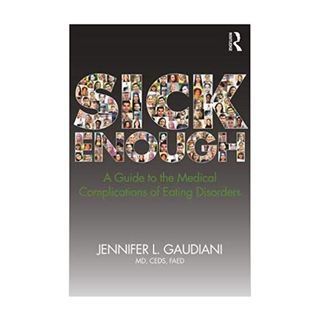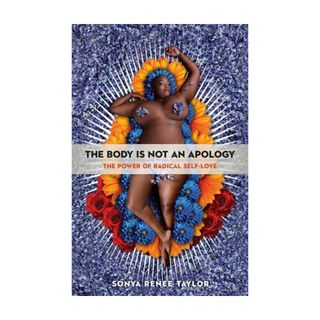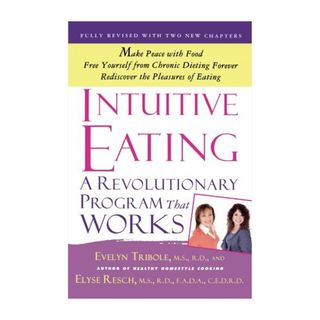Consider These 5 Eating Disorder Myths Debunked

In middle school, my health class was shown a made-for-TV movie about eating disorders. Its protagonist was a skeletal freshman girl who would hide jars of vomit in her closet. I don’t remember the name of the movie or what eventually happened to the character, but I can recall exactly what she looked like: concave stomach, protruding cheeks, a human reduced to skin and bones.
"This is what anorexia does to a person,” we were told. And yes, sometimes that’s how anorexia and bulimia manifest in someone’s appearance. And sometimes—dare I say, more often than not—these illness don’t present like that at all.
I spent the better part of my life feeling like I wasn’t sick enough to warrant seeking help because I didn’t look like the girl from the movie. This was just one of the internalized certainties I went into treatment with, along with the belief that everyone would be thinner than me, more type-A than me, better at having an eating disorder than me, and would need help more than me.
That, along with a whole made-for-TV–length list of other myths I’d been conditioned to believe, is what my brain told me for over a decade. Of course, upon entering treatment, I quickly was deprogrammed of these non-truths. Below, I identify the most prevalent myths I personally dealt with, and share how they were busted with the help of Jennifer Gaudiani, MD, a Denver-based internist who specializes in eating disorders.
MYTH: Eating Disorders Are a Wealthy White Woman's Disease
Truth: Eating disorders exist across the spectrum of human existence and are found in people across the world, rich and poor, all skin colors, all religions, all genders, and all body sizes and shapes. Eating disorders usually get kick-started during the course of restricted eating, whether in the service of a diet or total elimination of food groups or even food insecurity in the context of poverty.
MYTH: You're Cured Once You Weight-Restore
Truth: Because of western society’s obsession with thinness, many patients with anorexia nervosa get the message that once they’ve restored weight (meaning gained any weight back that they may have lost as a result of their eating disorder), the problem is solved. The fact is that eating disorders are complicated biopsychosocial illnesses. While weight restoration in is vital, it is by no means a panacea for all who struggle. Most patients with eating disorders of any shape or size need nutritional, therapeutic, and often medical support long beyond the point where they’ve achieved complete nutritional rehabilitation.
MYTH: Everyone with an Eating Disorder Looks Like They're Starving
Truth: The vast majority of those living with eating disorders do not have visibly underweight bodies. Binge eating is the most common eating disorder, followed by bulimia nervosa, while so-called "atypical anorexia nervosa” is characterized in the sizeist manual of mental illnesses, the DSM-5, as having all the distortions, food fears, and restrictive behaviors of anorexia nervosa, without being underweight.
The fact is that "atypical anorexia nervosa” is far more prevalent than anorexia nervosa! Patients with these diagnoses usually occupy bodies deemed by society as of "normal” or higher weight. This myth, however, can keep patients with this dangerous eating disorder invisible to their loved ones, social groups, and even the medical system because of the mistaken belief that someone has to be underweight to have an eating disorder.
MYTH: Eating Disorders Are Rooted in Vanity
Truth: Eating disorders are potentially deadly, life-altering mental illnesses that can be fully cured as long as they’re diagnosed and treated as early as possible—they’re so much more complicated than the desire to control one’s appearance. We have to remember that people in our society with more privilege (e.g., people who are light-skinned, smaller-bodied, able, cisgender, heterosexual, and financially stable, etc.) have better access to desirable outcomes: finding a job, getting a raise, having a partner, living free from daily hostility and judgment, sitting comfortably in an airplane seat, etc.
The medical system erroneously assumes a thinner body always means a healthier body and fully endorses diet culture to the detriment of millions. Thus, in desperation, many people turn to extreme or fad diets and end up with disordered eating habits or full-blown eating disorders when they were only trying to attain privilege and medical-defined "health” and freedom from microaggressions. As a society, we have to do better and embrace a broader representation of what it means to live in a healthy body!
MYTH: You Have to Weigh Over or Under a Certain Amount to Get Treatment
Truth: I wish I could bust this myth as thoroughly as the previous four. The fact is that eating-disorder treatment at all levels of care should be covered regardless of body shape or size—this seems like it would be the most medically sound and evidence-based approach. However, insurance companies (like the medical system they are embedded in) still often discriminate based on size. Many patients have experienced this, and I hope and expect that with time, this will change!
Recommended Reading
If you’re struggling with an eating disorder yourself—or want to become more informed so you can help others—Dr. Gaudiani recommends the following resources…
About The Chain
The Chain is a New York–based nonprofit that provides peer support for women working in the fashion and entertainment industries who are struggling with or recovering from an eating disorder.
The Chain was founded in December 2017 by Christina Grasso and Ruthie Friedlander, both in recovery from anorexia, after they encountered a need for a support network that addresses the challenges in eating disorder recovery unique to the fashion and entertainment industries.
The Chain aims to create a safe place for this population to share their experiences and gain insight through conversation, support, and community building. The Chain is peer-led and is not intended to be a substitute for professional medical advice, diagnosis, or treatment.
Learn more about The Chain here.
Next up: Four Women on What They Learned from Going to Therapy
Last week: This is What Life is Like After Eating Disorder Treatment
Disclaimer
This article is provided for informational purposes only and is not intended to be used in the place of advice of your physician or other medical professionals. You should always consult with your doctor or healthcare provider first with any health-related questions.
-
 This Founder Shares Why We Should Start Celebrating Rest
This Founder Shares Why We Should Start Celebrating RestBurnout is nothing to be proud of.
By Kia Topps
-
 Why Dr. Deepika Chopra Believes that Optimism is Resiliency
Why Dr. Deepika Chopra Believes that Optimism is ResiliencyWhy you should start embracing every feeling.
By Kia Topps
-
 How TikTok's Favorite Photographer Helped Me Find My Confidence
How TikTok's Favorite Photographer Helped Me Find My ConfidenceI renewed my relationship with myself.
By MacKenzie Green
-
 11 Things to Do If You're Dealing With Anxiety at Work
11 Things to Do If You're Dealing With Anxiety at WorkThese can help.
By Casey Clark
-
 Here's Why I Make Time for "Play" Every Day—and Why You Should Too
Here's Why I Make Time for "Play" Every Day—and Why You Should TooIt's one of the best things you can do for yourself.
By MacKenzie Green
-
 How to Choose a Plant Based on Your Personality Type
How to Choose a Plant Based on Your Personality TypeDo you have a green thumb?
By Sarah Yang
-
 If You're Super Stressed Out, These 17 Things Can Make You Feel Better
If You're Super Stressed Out, These 17 Things Can Make You Feel BetterTry them.
By Sarah Yang
-
 I Tried Pottery Classes as a Way to Better My Mental Health—Here's What Happened
I Tried Pottery Classes as a Way to Better My Mental Health—Here's What HappenedI left my classes with more than I bargained for.
By Kia Topps




